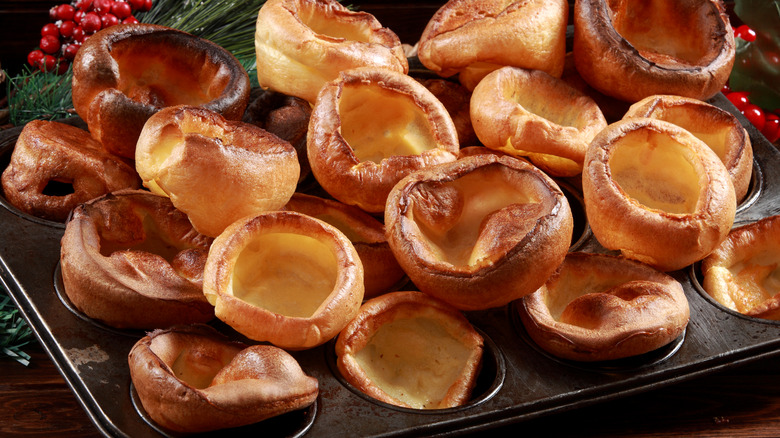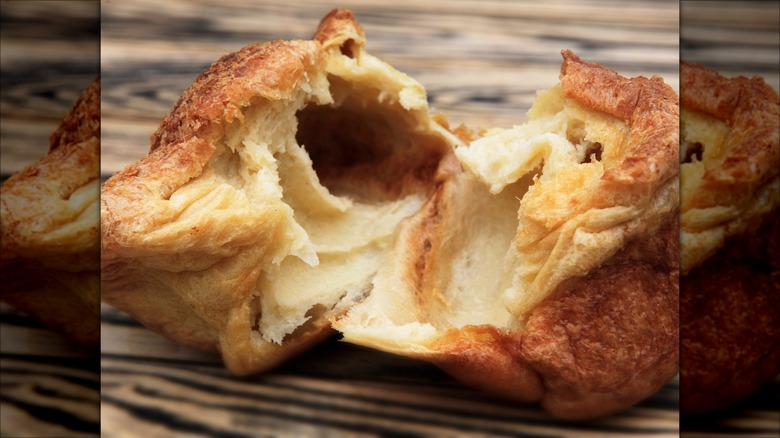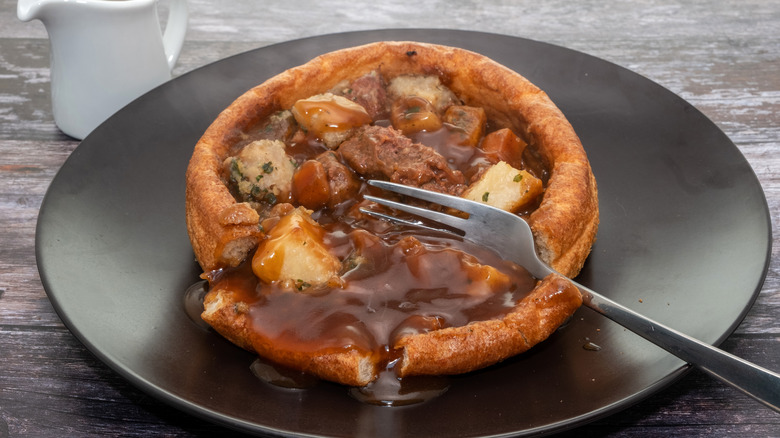Despite Its Name, Yorkshire Pudding Is Neither Pudding Nor Dessert
We may receive a commission on purchases made from links.
In the U.S., when you hear someone mention pudding, all kinds of sugary possibilities come to mind, including Jell-O pudding cups, cakes, pies made with fillings of flavored pudding, or the sweet custard carefully layered into handsome trifles. In the U.K., however, dessert puddings take on a broader meaning; they include traditional English desserts such as bready steamed cakes like spotted dick and plum pudding, or a saucy dessert like sticky toffee pudding. There, an offer of pudding can also mean a dessert as basic as a bowl of ice cream. If, however, someone offers you a pudding and hands you something that looks like a small, cratered bread, served with hot slices of roast beef and dark gravy, don't be alarmed. This is a pudding, too — specifically, it's a savory, British favorite called Yorkshire pudding.
Made from a thin, egg and flour-based batter, Yorkshire puddings are formed when this mixture is poured into a hot, oiled baking pan. Once in the oven, the batter rises and browns into a light, stretchy, pillowy puff. The puddings are flavored with meat drippings drizzled over the top or that are added to the baking pan before the batter goes in. The result is a baked batter bread that's delicious alongside savory roasted vegetables and meats.
How they're cooked is what ties different British puddings together
If you've ever had a popover, then Yorkshire puddings will look very familiar. One difference between them is that while popovers crisp up on the outside with butter, Yorkshire puddings typically use beef drippings or tallow. Yorkshire puddings, whether large or individual, are also baked in shallower cooking tins, so they don't have the height of popovers.
How did this savory, bread-like treat end up sharing a name with cakes and ice cream? What British sweet and savory puddings had in common in the old days was the method used to cook them: water, either boiling or steam. Desserts like plum pudding and spotted dick are cooked in tightly covered dishes that then sit in simmering water until they're steam-cooked through. Some sausages that are cooked in boiling water are also called puddings. Although Yorkshire puddings are baked, the thin, wet batter produces a lot of steam; the oven is kept closed to allow steam to puff the batter as it cooks.
Semantic change over decades and generations can be blamed for why so many dishes and desserts have come to be called puddings — even though one kind may not resemble another in any way.
Different ways to dig into a Yorkshire pudding
Yorkshire puddings can be prepared in different ways — served as a side to tear apart and mop up sauce or a receptacle for a savory dinner. One popular way is to prepare them individually, like a pot pie without a top — though the vessel is more a bread than a flaky crust. This turns them into large edible bowls, that get filled with roasted meats, vegetables, and oodles of gravy.
The pans used to prepare Yorkshire puddings look a lot like muffin pans except with wider and shallower wells. A squat rectangular baking pan is used to make one large Yorkshire pudding, which once baked can be sliced into pieces for serving. Americans may never get used to the idea of a pudding that's savory, but that shouldn't stop you from making a batch of Yorkshire puddings with your next meal of roasted beef.


